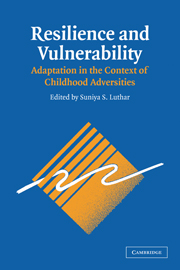Book contents
- Frontmatter
- Contents
- List of Contributors
- Foreword by Dante Cicchetti
- Preface
- 1 A Resilience Framework for Research, Policy, and Practice
- PART I FAMILIAL ADVERSITIES: PARENTAL PSYCHOPATHOLOGY AND FAMILY PROCESSES
- 2 Young Children with Mentally Ill Parents: Resilient Developmental Systems
- 3 Risk and Protective Factors for Children of Depressed Parents
- 4 Resilience and Vulnerability among Sons of Alcoholics: Relationship to Developmental Outcomes between Early Childhood and Adolescence
- 5 Maternal Drug Abuse versus Other Psychological Disturbances: Risks and Resilience among Children
- 6 Resilience to Childhood Adversity: Results of a 21-Year Study
- 7 Sequelae of Child Maltreatment: Vulnerability and Resilience
- 8 Risk and Resilience in Children Coping with Their Parents' Divorce and Remarriage
- 9 Correlational and Experimental Study of Resilience in Children of Divorce and Parentally Bereaved Children
- PART II EXOSYSTEMIC AND SOCIODEMOGRAPHIC RISKS
- PART III COMMENTARIES
- Index
- References
5 - Maternal Drug Abuse versus Other Psychological Disturbances: Risks and Resilience among Children
Published online by Cambridge University Press: 05 June 2012
- Frontmatter
- Contents
- List of Contributors
- Foreword by Dante Cicchetti
- Preface
- 1 A Resilience Framework for Research, Policy, and Practice
- PART I FAMILIAL ADVERSITIES: PARENTAL PSYCHOPATHOLOGY AND FAMILY PROCESSES
- 2 Young Children with Mentally Ill Parents: Resilient Developmental Systems
- 3 Risk and Protective Factors for Children of Depressed Parents
- 4 Resilience and Vulnerability among Sons of Alcoholics: Relationship to Developmental Outcomes between Early Childhood and Adolescence
- 5 Maternal Drug Abuse versus Other Psychological Disturbances: Risks and Resilience among Children
- 6 Resilience to Childhood Adversity: Results of a 21-Year Study
- 7 Sequelae of Child Maltreatment: Vulnerability and Resilience
- 8 Risk and Resilience in Children Coping with Their Parents' Divorce and Remarriage
- 9 Correlational and Experimental Study of Resilience in Children of Divorce and Parentally Bereaved Children
- PART II EXOSYSTEMIC AND SOCIODEMOGRAPHIC RISKS
- PART III COMMENTARIES
- Index
- References
Summary
The primary thesis of this chapter is one that flies in the face of rampant stereotypes: that maternal drug abuse is not necessarily more damaging to children's social-emotional well-being than are other maternal psychiatric disorders. It is widely believed that women who abuse illicit drugs are not just dissolute as individuals but also deplorable as parents, with children who, more so than offspring of parents with other mental illnesses, are disruptive, disturbed, or dysphoric. Empirical evidence supporting such beliefs, however, is tenuous at best. In this chapter, we present data from our own ongoing research to elucidate adjustment patterns among children whose mothers have histories of drug abuse. Our primary objective is to disentangle the degree to which risks to children accrue from maternal histories of drug abuse per se, rather than from various other adversities with which this disorder typically coexists.
A second objective is to determine the degree to which different forces, at the levels of the community, family, and child, might mitigate or exacerbate the risks faced by children of drug abusers – an exercise of pragmatic value in light of the magnitude of the risks. It is estimated that approximately 3 million American women regularly use illicit drugs such as cocaine and opioids (e.g., National Center on Addiction and Substance Abuse, 1996). Furthermore, most of these women retain responsibility for their minor children and negotiate the everyday challenges of parenting in the context of not only other psychiatric disorders (co-occurring with their addiction) but also scarce financial and emotional resources (McMahon & Luthar, 2000).
- Type
- Chapter
- Information
- Resilience and VulnerabilityAdaptation in the Context of Childhood Adversities, pp. 104 - 129Publisher: Cambridge University PressPrint publication year: 2003
References
- 10
- Cited by



